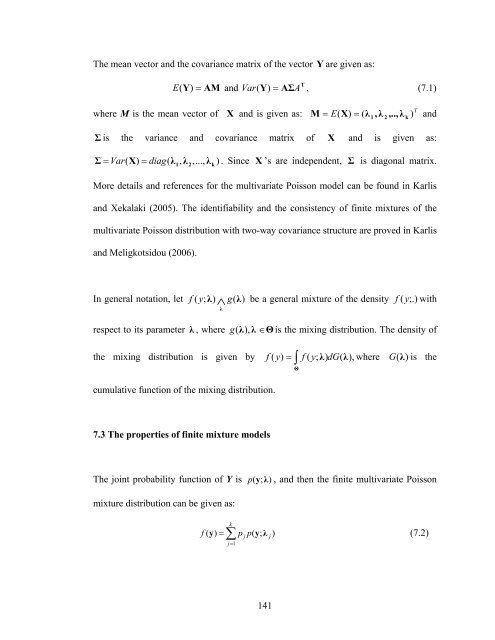multivariate poisson hidden markov models for analysis of spatial ...
multivariate poisson hidden markov models for analysis of spatial ...
multivariate poisson hidden markov models for analysis of spatial ...
Create successful ePaper yourself
Turn your PDF publications into a flip-book with our unique Google optimized e-Paper software.
The mean vector and the covariance matrix <strong>of</strong> the vector Y are given as:<br />
T<br />
E ( Y ) = AM and Var ( Y)<br />
= AΣA<br />
, (7.1)<br />
where M is the mean vector <strong>of</strong> X and is given as:<br />
M =<br />
T<br />
= E ( X)<br />
( λ<br />
1<br />
,λ<br />
2<br />
,.., λ<br />
k<br />
) and<br />
Σ is the variance and covariance matrix <strong>of</strong> X and is given as:<br />
Σ = Var( X) = diag( λ1, λ2,..., λ<br />
k)<br />
. Since X ’s are independent, Σ is diagonal matrix.<br />
More details and references <strong>for</strong> the <strong>multivariate</strong> Poisson model can be found in Karlis<br />
and Xekalaki (2005). The identifiability and the consistency <strong>of</strong> finite mixtures <strong>of</strong> the<br />
<strong>multivariate</strong> Poisson distribution with two-way covariance structure are proved in Karlis<br />
and Meligkotsidou (2006).<br />
In general notation, let f ( y;<br />
λ)<br />
∧ g(<br />
λ)<br />
be a general mixture <strong>of</strong> the density f (y;.)<br />
with<br />
λ<br />
respect to its parameter λ , where<br />
g(<br />
λ),<br />
λ ∈Θ<br />
is the mixing distribution. The density <strong>of</strong><br />
the mixing distribution is given by f ( y)<br />
= f ( y;<br />
λ)<br />
dG(<br />
λ),<br />
where G(λ)<br />
is the<br />
cumulative function <strong>of</strong> the mixing distribution.<br />
∫<br />
Θ<br />
7.3 The properties <strong>of</strong> finite mixture <strong>models</strong><br />
The joint probability function <strong>of</strong> Y is p( y; λ ), and then the finite <strong>multivariate</strong> Poisson<br />
mixture distribution can be given as:<br />
k<br />
f( y) = ∑ pjp( y; λ<br />
j)<br />
(7.2)<br />
j=<br />
1<br />
141















